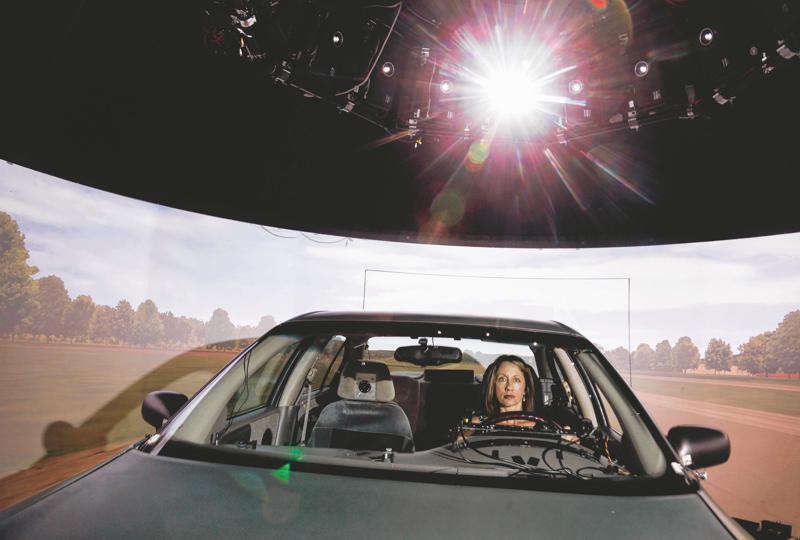Senior research scientist Cher Carney drives NADS-1, a high-fidelity ground vehicle driving simulator, at the National Advanced Driving Simulator at the University of Iowa in Coralville in July 2017. The University of Iowa Driving Safety Institute recently received a $2 million grant from the National Highway Traffic Safety Administration to evaluate how effective driver monitoring systems are at determining whether someone is drunk driving. (Jim Slosiak/The Gazette)
IOWA CITY — After a dramatic drop in drunk driving deaths in the 1990s, progress has stalled nationwide, prompting University of Iowa researchers to study whether expanding automotive technology can again make a difference.
The UI Driving Safety Institute, home to the National Advanced Driving Simulator, recently won $2 million in funding from the National Highway Traffic Safety Administration to evaluate how effective a new driver monitoring system is at determining whether someone is drinking while driving.
“At the end of the day, the question is, how do these systems work, how effective are they, what is their potential to reduce fatalities,” said Tim Brown, director of drug-driving research at the UI Institute. “There’s been a lot of effort to try to reduce those numbers, but the situation isn’t getting any better.”
According to the U.S. Department of Transportation and the National Highway Traffic Safety Administration, the total number of traffic fatalities over the past decade has soared from 32,893 in 2013 to 42,514 in 2022, with the rate of drunk driving fatalities rising accordingly to 32% from 30% 10 years ago.
Of the 13,524 people who died in alcohol-related crashes in 2022 (up from 10,084 in 2013), 59% were drunk drivers, 12% were passengers, 16% were occupants of other vehicles, and 12% were non-passengers, such as pedestrians or cyclists.
“So I guess the question now is, are there technological ways we can help reduce these things – distraction, drowsiness, alcohol -” Brown said, noting that his team is also researching tools to help prevent drowsy and distracted driving. “How can new technology help us avoid being involved in these accidents?”
Technology Opportunities
As ever-evolving driver monitoring systems are designed and installed in more vehicles, the opportunities for technology to help address these major societal issues are growing.
For example, some can use cameras that can track eye and head movements to warn drivers to stop and take a break or keep their eyes on the road.
“So the question is, to what extent can that kind of technology be used to determine whether someone is legally incapacitated,” Brown said. “Are there characteristics that can be observed from measures like vehicle control, such as how the vehicle is operated?”
Brown asked if there were facial reaction cues or steering wheel sensors that could measure heart rate and breathing, which could be indicators of alcohol consumption.
“We’re really trying to understand the feasibility of protecting drivers who are over the legal limit, and also looking at distinguishing that from other types of impairment, such as when a driver is asleep at the wheel,” he said.
A new generation of systems is being developed to determine whether a driver’s blood alcohol level is above the legal limit, but Brown said one of the big challenges is not just determining if a driver is intoxicated, but determining what state they are intoxicated in, how intoxicated they are, and what to do about it.
“You need to know how they’re impaired to know what to do,” he says, “so if someone is distracted, you don’t want to offer a response designed to help someone who’s sleepy.”
UI’s study of alcohol-related driver monitoring systems puts participants in a driving simulator and tests them in four different conditions: alert and sober, drowsy and sober, with a blood alcohol content of 0.08 and a BAC of 0.12.
The researchers plan to collect data on drivers’ driving performance, eye tracking, head and body movements, heart rate, and breathing to determine “which of these metrics are most sensitive in distinguishing between types of impairment.”
Preparation
The alcohol-related study is in the preliminary stages, determining the appropriate sensors, cameras and other technologies to use. Researchers also need to determine the best “driving environment” to test.
“Drunk driving can happen anywhere,” he said, “but there are certain areas where it’s more prevalent in terms of crashes and fatalities, so we look closely at the driving environment and try to ensure that the locations where we do our testing reflect those where the risk is greatest.”
The plan is to begin pilot studies later this year and fully expand data collection next spring.
Brown and his team are also conducting separate research into distracted and drowsy driving, and monitoring systems that might help.
“There’s a lot of technology being put in place to help people make better choices,” he said. “It’s just another opportunity to do that in a variety of areas.”
How to participate?
Eligible participants will be recruited through the university’s drivingstudies.com beginning in spring 2025.
Vanessa Miller covers higher education for The Gazette.
Comments: (319) 339-3158; vanessa.miller@thegazette.com

